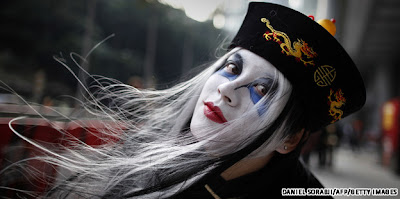On Halloween night in medieval Ireland and Britain the poor went door to door requesting food in return for prayers for the dead. This gave rise to "guising," a tradition in which Scottish and Irish children disguised themselves in costumes as they canvassed the neighborhood for food and coins.
At the center of Irish Halloween customs is
Báirín Breac (barmbrack), a yeasted bread baked with sultanas and raisins:
 |
| Barmbrack, a Halloween tradition |
The Halloween Brack traditionally contained various objects baked into the bread and was used as a sort of fortune-telling game. In the barmbrack were: a pea, a stick, a piece of cloth, a small coin (originally a silver sixpence) and a ring. Each item, when received in the slice, was supposed to carry a meaning to the person concerned: the pea, the person would not marry that year; the stick, "to beat one's wife with", would have an unhappy marriage or continually be in disputes; the cloth or rag, would have bad luck or be poor; the coin, would enjoy good fortune or be rich; and the ring, would be wed within the year. 1
Other Irish Halloween traditions include
na h-úlla ag bogadhál ar bharr an uisce (bobbing for apples) and Snap Apples, a game in which participants bite at apples dangling from strings while their hands are tied behind their backs. The first person to bite into a coin hidden inside the apple wins. It is even more challenging when a lit candle is tied to the hanging stick.
Hong Kong
 |
Hong Kong. Photo by Dorothy Tang,
http://news.bbc.co.uk/2/hi/in_pictures/6096146.stm
|
In Hong Kong, with its long history of Western influence, you're sure to find westernized Halloween-themed costume parties and celebrations. But contrary to what you may have read on the internet, Halloween is not observed in mainland China.
Teng Chieh, The Lantern Festival (also
Yuán Xiāo Jié 元宵
), is the holiday most often mistakenly identified as the Chinese Halloween.
Held on the 15th day of the Lunar New year to mark the first full moon and the lengthening of days, Teng Chieh is observed near the
end of February. Lanterns of many shapes and sizes are paraded through the streets and kerosene-fueled hot-air lanterns are released into the sky to "convey messages to the gods to bestow luck on the people below." In her superb article on the
Lantern Festival, Qui Gui Su describes the festival's origin nearly 2,000 years ago during the Han dynasty (206 BCE—221 CE):
"Yuan Xiao (a maiden in the emperor's palace) had a luxurious life, but she missed her family and wanted to see them during the New Year celebrations. This was not allowed.
So Yuan Xiao devised a clever plan to sneak out of the palace. She told the emperor that the God of Fire had visited her and told her of his plans to burn down the entire city. She offered this advice to the emperor – 'Make the city look like it is already on fire, then the God of Fire will go away.'
So the emperor ordered lanterns to be lit throughout the city and firecrackers to be set off. During the confusion, Yuan Xiao was able to get away unnoticed and had a joyous reunion with her family."
As can be seen, the Lantern Festival has nothing to do with Halloween.
Qīng Míng (Tomb-sweeping Day)
Qīng Míng,
held in April, is when families honor deceased kin by visiting and tending to ancestral graves. I remember
Qīng Míng as a time when relatives gathered at the cemetery to pull weeds, trim shrubs and sweep my grandparent's grave. Once the tomb was cleaned a feast of rice, roast pork, chicken, eggs, tea and whiskey was laid before the headstone.
"Bai san," Mom would say, prompting my brothers and me to take turns greeting Grandmother and Grandfather, offer food, and bow three times. Paper spirit money, houses and clothes were burned to insure their comfort in the next world, and fireworks were lit to scare off lingering evil spirits. Later, the entire extended family would gather for a feast of remembrance.
Zhōng Yuán Jié (Hungry Ghost Festival)
Zhōng Yuán Jié, observed in August, is when the gates of heaven and hell swing open, allowing the dead to pass into this world and walk among us. Disgruntled souls of those who died of unnatural causes or who were not properly buried hunger to unleash their acrimony on the living. According to
Qiu Gui Su,
"This makes ghost month a bad time to do activities such as evening strolls, traveling, moving house, or starting a new business. Many people avoid swimming during ghost month, since there are many spirits in the water which can try to drown you."
Sumptuous feasts and elaborate spirit items are offered at shrines and altars to placate the hungry ghosts, and paper boats and lanterns are released on water to guide them home.
Mexico
 |
| Day of the Dead observance. |
Although Halloween is celebrated on October 31st much as it is here in the States, with costumes and parties among friends and family, the holiday holds a much more serious tradition as a time when the souls of the deceased return to earth to be among family and friends.
November 1st is
Dia de los Angelitos (Day of the Little Angels), dedicated to the remembrance of infants and children who have died, and November 2nd is
Dia de los Muertos (Day of the Dead), when friends and family honor adults they have lost.

Catrina figure | 
Sugar skulls |
Dia de los Muertos observances vary from region to region. Oftentimes elaborate shrines are built, and families visit graves and altars to share remembrances and favorite foods and beverages with the deceased. Two areas best known for their Day of the Dead celebrations are
Oaxaca and
Michoacan. You're sure to see plenty of
calaveras de azúcar (sugar skulls) and
Catrina figures!
©2011 Tammy Yee








































































